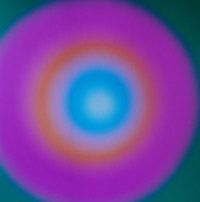Julien Levy Gallery, first floor, Perelman Building
Main Building

Sudan, negative 2001; print 2008 Milan Fano Blatný, Czech Gelatin silver print From the series Photo-Mandala Courtesy of the artist
This visually bold exhibition of more than thirty photographs brings together two contemporary artists whose work has been inspired by the ancient form of the mandala. These images, made in color by Bill Armstrong (American, born 1952) and in black-and-white by Milan Fano Blatný (Czech, born 1972), are not meant specifically for sacred use. Still, they evoke the traditional structure of the mandala, in which symbolic colors, shapes, and subject matter emanating from a central core inspire contemplation and wonder.

Mandala 453, negative 2003; print 2008 Bill Armstrong, American Chromogenic print From the series Infinity Courtesy of the artist
Mandalas are a visual aid to concentration and meditation that have been used in Buddhist and Hindu religious practices for centuries. The word mandala can be translated as "circle" in Sanskrit (a classical language of India). Like the Christian cross or the Jewish Star of David, the mandala consists of very simple shapes that stand for complex and profound ideas. Conceived as a diagram of the divine palace or realm of a deity, the mandala is, more broadly, a visualization of the entire cosmos. Its traditional design often includes circles and squares and can incorporate figures and colors that further enhance its meaning. A circle is sometimes considered a symbol of the sacred realm, while a square stands for the earth or the man-made world. In the I Ching, an ancient Chinese philosophical text, these shapes correspond to yang (male, celestial energy) and yin (female, receptive energy). The center of a mandala—or abode of the deity—is located within a square—the palace of inner being—which is then surrounded by a series of concentric circles, each representing a level of consciousness. This graphic diagram is a gateway that encourages a journey away from the concerns of everyday life (the periphery) toward a sense of harmony and spiritual wholeness (the center), or the reverse. To learn more about mandalas and the art and culture of India and the Himalayan region, visit .

Mandala 464, negative 2007; print 2008 Bill Armstrong, American Chromogenic print From the series Infinity Courtesy of ClampArt
"The Mandalas are meant to be meditative pieces—glimpses into a space of pure color, beyond our focus, beyond our ken. Their essential purpose is to create a sense of transcendence, of radiance, of pure joy," Bill Armstrong writes about this series. "Through abstraction, simplification and blur, I hope to create a context for the exploration of broad spiritual themes that, rather than relying on a codified system, remains open and invites the viewer's personal interpretation." Like other portfolios in his series Infinity, Armstrong's mandalas are made from collages he creates and then photographs with the camera's focusing ring set on infinity. He then creates chromogenic prints from the resultant negatives. By taking an out-of-focus photograph, the artist concentrates not on detailed form and subject but on the rich, saturated colors that shift and pulsate in relation to one another, inviting an inquiry into the interconnectedness of all things. Bill Armstrong is a New York City based fine art photographer who has been working in color for over 30 years. He has been a photography instructor on the faculty of the International Center of Photography since 2001 and an adjunct professor of photography at the School of Visual Arts since 2003. Mr. Armstrong's work is in museum collections worldwide including the Philadelphia Museum of Art; the Brooklyn Museum; the Museum of Fine Arts, Houston; Santa Barbara Museum of Art; the Musée de l'Elysée in Lausanne; and the Centro Internazionale di Fotografia in Milan. Mr. Armstrong is represented by ClampArt in New York and numerous galleries across the country and in Europe.

Sudan, negative 2001; print 2008 Milan Fano Blatný, Czech Gelatin silver print From the series Photo-Mandala Courtesy of the artist
"The more you look at the image, the more you see," the artist, known as Fano, writes about his photographic mandalas. "New worlds, new levels come up from the centre of the picture—and you can go deeper and deeper inside the image." By selecting a square sheet of paper for these complex images, the artist also surrenders himself to any predetermined idea of up or down, left or right, past or future: "Everything happens at the present moment while you are viewing the image. Just unity. A circle with no beginning, never ending, inner peace." Fano creates these gelatin silver prints from his Photo-Mandala series using a labor-intensive process that does not involve a computer. "I believe this way I can keep the energy of the prints. Each photo-mandala is a record of one real moment from my life," he explains. Many of the images are named for the places where the photographs were made. Milan Fano Blatný (Czech, born 1972) lives in Brno, Moravia, in the Czech Republic. He began his photographic career at the end of the 1990s and has completed numerous bodies of work made across the globe, particularly in Asia. Fano's work is included in the collections of the Museum of Fine Arts, Houston; Museet for Fotokunst in Odense, Denmark; Kiyosato Museum of Photographic Arts in Kiyosato, Japan; and numerous individuals. Fano's work has been exhibited at the photography festival Rhubarb-Rhubarb in Birmingham, England; and at The University of the Arts in Philadelphia. Among other distinctions, he was winner of the FOTOFO Foundation's Portfolio Review prize in Bratislava, Slovakia, in 2003 and was awarded first prize in the annual competition of The Photo Review in 2004, which was juried by Katherine Ware, the Philadelphia Museum of Art's Curator of Photographs, who curated this exhibition. His work is represented by John Cleary Gallery in Houston.
Julien Levy Gallery, first floor, Perelman Building
Main Building
Katherine Ware • Curator of Photographs